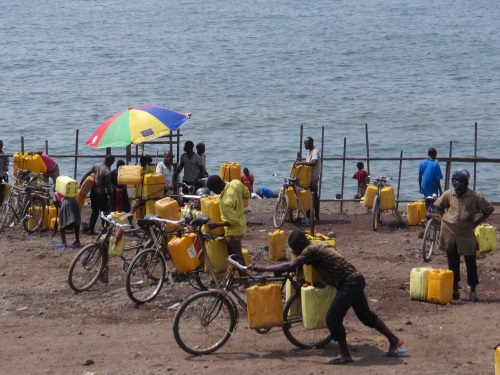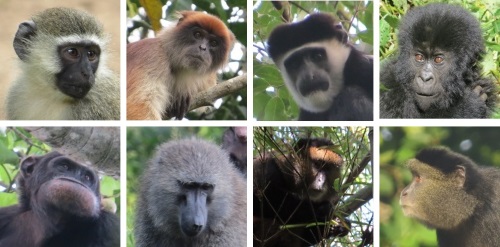Blog Countries
Tips for Rwanda, Congo and Uganda
Right after Christmas I spent 3 weeks travelling around Rwanda, DR of Congo and Uganda. It was a great and well-balanced trip, that covered 2 TWHS and 4 WHS. 2 out of the latter had not been reviewed before on this website, so this is some real undiscovered territory. Find below my Top Tips for Travelling to Rwanda, Congo and Uganda as a World Heritage Traveller.
| Want to see the hippos of the Ugandan Kazinga Channel? 40 US dollar entrance fee + 28 US dollar boat ride |
1. Go there when you can afford it
In preparation I read trip reports from people who travelled in this region without entering any of the major National Parks. They only had the money to sustain their daily travel costs of food, public transport and lodging. I’d say: be prepared that these are expensive destinations, and that you’ll enjoy them more if you have saved up a bit. You’ll easily be asked to hand over 50 to 100 US dollar for any activity on top of entrance fees (the Ugandan Wildlife Service provides a handy leaflet with pricing). And you’ll also have to pay for mostly private transport getting into the parks and out again. There’s not much of interest in the towns and cities in this area that you can see under your own steam.
2. Now is the time to aim for these Congo WHS
So I already proved that Virunga is easily doable. What about the others? The lowland gorillas of Kahuzi-Biega can be accessed in a similar way, on a short dash from the border with Rwanda. Or do a combination tour of these 2 WHS, an itinerary that is offered by various agents (such as Green Hills Ecotours and Amani Safaris). You'll also pass through the city of Bukavu, of Art Deco interest. Here's what a more or less independent traveller has to say about this area. Okapi Wildlife Reserve is advertised too at the moment by Congolese tour companies. Even Garamba in the far north-east flirts with tourists again, as its website states that contact has been made "to set up joint safaris" with Virunga and Epulu (Okapi) Park. Only Salonga seems to be virtually off-limits to tourists. The 2012 edition of the Bradt Guide to Congo states that visiting the Salongas is "one of the most difficult things to do in the DR Congo".
 |
| Filling jerrycans of drinking water from Lake Kivu (Congo) |
3. Don’t be scared by ‘Africa’
Rwanda and Uganda are said to be the safest and easiest African countries to travel in. But so are Morocco, Ghana, Botswana and Namibia. And Gambia, Senegal, Kenya, Tanzania, Ethiopia, Madagascar and South Africa are well on-the-beaten-track even for package holidays or group tours. I’d travel independently to all these without a doubt. A visa for Rwanda & Uganda can be picked up on arrival – they share a handy multiple entry East Africa visa with Tanzania. And a special DR of Congo visa will be reserved for you when you book for Virunga, with no hassle at the border. Just pay 105 USD and you will be put on the list to receive a visa stamp: here’s that ‘allocate money’-tip #1 again.
4. This trio of countries makes an excellent combination
Distances in the border area between Rwanda, Congo and Uganda are fairly short. My whole 3 week route was only 1200 km long. I never had to travel for more than a few hours to get from A to B, even on public transport. The best itinerary to pick up the 3 WHS and 2 TWHS in this region seems to be: Kigali – Ruhengeri – Goma (border) – Rumangabo – Bunagana (border) – Kisoro – Kabale - Kasese - Fort Portal. The Bunagana border between Congo and Uganda is open, and provides quick access from or to Virunga (ca. 2 hours). Although the three countries share a similar landscape, their general atmosphere differs greatly. Orderly Rwanda, with a genocide memorial in each town and armed police at every street corner (they have the most fierce traffic police that I ever encountered). Uganda with its British colonial touches (love of paperwork, tea plantations and education) and very welcoming and chatty inhabitants. And bewildering Congo, from the quirky statue of a golden chukudu in central Goma to a dishevelled soldier standing guard every 500m along the road to Rumangabo.
 |
| 8 different ape and monkey species seen on this trip |
5. You’ve got to love your apes and monkeys
If your focus is on cultural WHS, this isn’t the kind of trip for you. This was mostly a nature journey, where 'tracking' of various species of apes and monkeys alternated with shorter nature hikes, birding and a safari-type drive & boat ride. I enjoyed the excitement that comes with the searching for and - eventually - spotting (larger) mammals. And even a small, colourful bird (kingfisher!) can hold my attention. A good general trip report about what wildlife in SW Uganda has to offer can be found here.
Els - 30 January 2016
Comments
Els 3 February 2016
Hi Clyde,
They can be found under the label "Countries" in the Index at http://www.worldheritagesite.org/blog/blog.php.
Clyde 2 February 2016
Are such overviews stored somewhere accessible on the website after their week or two of glory? It would be interesting to have a section on the forum or somewhere to be able to view them again at leisure.
Ian Cade 2 February 2016
Will second Philipp's post. Whilst natural sites don't tend to top my list of "must sees" these reports have been great. And I really enjoy these end of tour overviews, thanks for posting them.
Philipp Peterer 30 January 2016
You really made me wanna go there. Thanks for all the reports Els!